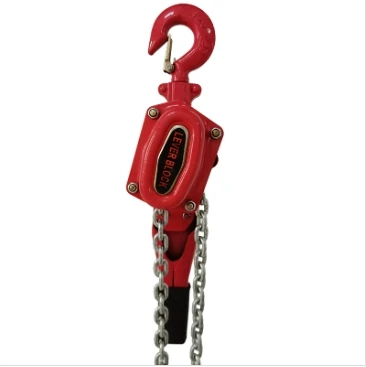


Understanding Lever Blocks Mechanisms and Applications
In the world of mechanical devices, lever blocks stand out as powerful tools designed for lifting heavy objects with minimal effort. Lever blocks, also known as lever hoists, are essential in various industries, including construction, shipping, and warehousing. Their innovative design simplifies the process of moving heavy loads, and understanding how they work and their applications is crucial for anyone involved in heavy lifting tasks.
What is a Lever Block?
A lever block is a type of hoisting equipment that uses a lever mechanism to raise, lower, or move loads. It consists of several key components, including a sturdy frame, a lever arm, a load hook, and a ratchet and pawl system that secures the load in place once lifted. The basic principle of a lever block is based on the physics of leverage, where a smaller force applied at a longer distance from the fulcrum can lift a heavier load positioned closer to it.
How Does a Lever Block Work?
The operation of a lever block is relatively straightforward. To lift a load, the user pulls down on the lever arm, generating a force that is multiplied through the lever system. As the lever moves, the attached chain or cable wraps around a drum, raising the load attached to the hook. The ratchet and pawl mechanism ensures that the load remains securely suspended once lifted, preventing any accidental descent.
The efficiency of lever blocks lies in their mechanical advantage, which allows users to lift objects many times their own weight with only a fraction of the effort. The unit's compact design and portability make it an ideal choice for various lifting tasks, from raising construction materials to securing cargo in transit.
Types of Lever Blocks
There are several types of lever blocks available on the market, each suited for specific applications. The most common ones include
1. Manual Lever Hoists These are operated solely by human force, making them cost-effective and suitable for DIY tasks and small-scale operations. 2. Electric Lever Hoists These utilize electric power to operate, providing a significant advantage when lifting very heavy loads or when used in repetitive tasks.

3. Pneumatic Lever Hoists These run on compressed air, making them suitable for use in hazardous environments where electrical equipment may pose a risk.
4. Chain Lever Hoists Featuring a durable chain, these hoists are exceptionally resilient and can handle various load capacities, depending on their design.
Applications of Lever Blocks
Lever blocks have a myriad of applications across different industries. In construction, they are frequently used to lift heavy materials such as beams and scaffolding. In shipping and logistics, lever blocks facilitate the loading and unloading of containers, ensuring efficiency and safety. In maintenance and repair operations, these hoists help lift engines, machinery, and other heavy components, simplifying tasks that would be otherwise labor-intensive.
Additionally, lever blocks are beneficial in emergency situations, such as vehicle recoveries or building collapses, where heavy lifting equipment is needed swiftly to save lives and secure safety.
Safety Considerations
While lever blocks are incredibly useful, they must be used with caution to ensure safety. Users should always check the load capacity specified by the manufacturer, as exceeding this limit can result in equipment failure. Regular maintenance is essential to identify wear and tear, particularly on moving parts like the chain and ratchet mechanism. Furthermore, proper training on how to operate a lever block safely is crucial to prevent accidents.
Conclusion
In summary, lever blocks are invaluable tools in the mechanics of lifting heavy loads efficiently and safely. Their easy operation, combined with their ability to provide significant mechanical advantage, makes them essential in many industries. Whether for construction, logistics, or emergency situations, understanding lever blocks and their proper usage can greatly enhance productivity and safety in the workplace. As technology continues to evolve, we can expect further innovations in lever block design and functionality, ensuring that they remain critical tools in heavy lifting for years to come.



